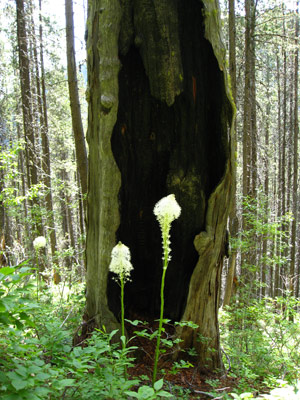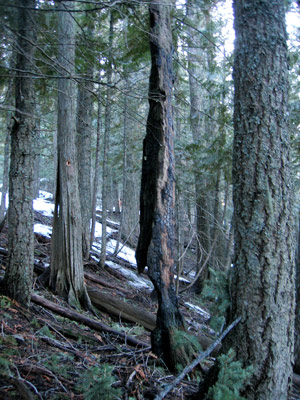|
||||
|
|
|
|
|
|
|||||||
 |
This snag seen on the way to Iron Mountain in the Cabinets is presumably a remnant of the 1910 fire PHOTO BY JIM MELLEN |
On that same day, in the mountains south of Cabinet, the rail town just east of Clark Fork, William Brashear’s crew of 32 men were fighting an independent fire in Defoe Gulch in the Dry Creek drainage when the big fire from the south broke over the top and into the gulch, catching them in between. Brashear had been to Clark Fork to consult with Pend Oreille Forest Reserve Assistant Supervisor Ed Stahl and was going back up Dry Creek to meet his crew when he met them coming down, fleeing the fire. After accounting for all of his men, Brashear led them to a clearing with a spring and had them soak their blankets and take refuge beneath them as the fire raged over the top of them.
Two men, though, “were stampeded,” as Brashear later put it; he couldn’t stop them from running. They were found barely out of the clearing, one evidently suffocated, the other burned beyond recognition. They were both “greenhorns,” possibly indigents recruited in desperation by the Forest Service for firefighting from out of Spokane. They were identified as J. Plant of Hope, Virginia, and J. Harris of Montreal, Quebec. They were both buried at Clark Fork.
The north face of the Bitterroots from the mouth of the Clark Fork River to Thompson Falls and beyond was scorched beyond recognition in a few short days. In many places, the fire jumped the Clark Fork – just plain blew across it – and began into the mountains north of the river.
Along the Idaho-Montana border at Clark Fork, at Cabinet and Heron, the fire approached from the south, burning across the divide into Johnson Creek, Dry Creek, Elk Creek, Pilgrim Creek and on to the east. Ruth McQuaide, née Dettwiler, was 3 years old at the time, living on a ranch across the river from Heron, and she describes the time in a letter to Elinor Compton, written in 1984.
“For days, we had not seen the sun. It was just a red ball in the sky. The air was thick with smoke. There was an eerie feeling of oppression and iminent (sic) danger. Roy (Ruth’s 5-year-old brother) and I did not want to play. The animals were confused. We knew our parents were very worried.
“One day, small fires began to appear on Squaw Peak (now Star Peak), and on the heavily timbered flat towards the (Clark Fork) river. One could see burning pieces of branches flying through the air.”
One of those firebrands started the blaze that made that scar on Billiard Table.
Downstream of the Dettwiler place, folks living on the Cabinet Flats and in Cabinet waded to a sandbar in the middle of the Clark Fork just downstream of the Cabinet Gorge and watched the fire jump the river, and then watched their world burn up.
West of Sandpoint at Wrencoe, Laclede, Priest River, Priest Lake and Newport, smaller fires that had been burning, some of them for nearly a month, blew up on the 20th, also, brought to colossal sizes by the same front of wind that kindled the blowtorch which seared the Silver Valley. Six miles north of Newport, along the Pend Oreille River, Ernest Deinhardt was swept off his feet by this blast of air as he tried to save his buildings. His sons also were “picked up and carried some distance” by the wind as they tried to find their father.
The father and sons did manage to find each other and took refuge in the root hollow of a huge, blown-over larch, covering as much of themselves as possible with dirt. They survived, though all were badly burned. Ida Deinhardt, though, wife and mother, died in the root cellar she had tried to convince her sons to enter with her. Her “almost cremated” remains were found on Monday, the 22nd.
Also burned to death nearby was George Ziegler, in an attempt to return from Newport to his farm down the river. Facing a road blocked by timber fallen by the same wind that buffeted Ernest Deinhardt and his sons, he abandoned his team and wagon. He was found less than 100 yards from the dead horses.
 |
This snag from the 1910 fire stands on the north face of Fatman Mountain in the east fork of Blue Creek, Montana PHOTO BY JIM MELLEN |
The raging fires of that weekend burned a sawmill at Laclede, though A.C. White Lumber Company’s mill at Laclede was spared. Their timber crews were already in the woods fighting fire, having been sent out a month before to battle blazes around the town.
South of Sandpoint and west of Lake Pend Oreille, a strip of country beginning at the Kootenai County line three miles wide and 20 miles long burned up with dozens of farms, homes and businesses lost. Nobody was killed by the flames, but many barely escaped with their lives, and often these people were left destitute as the fire they ran from ate up their life’s work, as well as millions of board feet of standing timber and thousands of dollars worth of posts, poles, cordwood and lumber waiting to be sent to market. The names of families who lost all or part of their investment in Bonner County included Pontius, Montout, Brown, Frick, Swigerts, Hagan, Leiik, Husted, Craig, McKinney, Matthews, and Kloph. In Sagle proper, in spite of the efforts of dozens of men fighting the flames, Oliver and Thomas Turnbull lost their store and Krum’s boarding house burned to the ground.
Northeast of Sandpoint and southeast of Bonners Ferry, a huge, pretty much unpopulated chunk of the western Cabinets burned, including the drainages of Kootenai River tributaries Boulder Creek and Twenty-Mile Creek and Grouse Creek, which feeds the Pack River. Hundreds of acres on the east face of the Selkirks were scorched near Copeland and along the border at Porthill. These fires were all in Bonner County at that time, as Boundary County was not formed until 1915.
Sandpoint, though spared the full horror of the fire, suffered its losses. Two young men from the city, George Strong and Andrew Bourrett, both died fighting fire in the Swamp Creek canyon near Trout Creek, Montana. They were buried at Lakeview Cemetery. Clarence Ames of Wrencoe traveled to Wardner, near Kellogg, to claim the body of his brother R.A. and take it “home to Minnesota.”
The worst of the damage was done and the wind had stopped by the evening of the 21st. The weather cooled and the fires began to decline. On the 26th, the Pend d’Oreille Review reported “a deadly frost,” and a few days later, the first snows appeared in the Cabinets, Selkirks and Bitteroots.
By Sept. 2, the worst forest fire season ever was over, and folks all over the Inland Northwest were left to count their losses and mourn their dead. Ninety-two souls perished, both firefighters and civilians. Hundreds more were scarred for life, and thousands lost part or all of everything they had. “1910” and “fire” were fused together in the Western lexicon.
The entire contents of this site are COPYRIGHT © Keokee Co. Publishing, Inc. All rights reserved.
